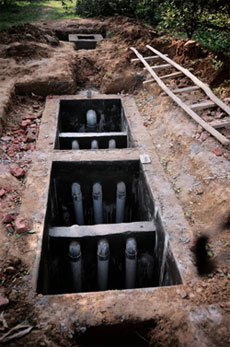Wastewater recycling
The wastewater recycling system at CSE has been designed to treat 8000 litres per day based on the assumption that at any given moment at least a 100 persons would be ocupying the premises. The components involved in treatment are a settler, a baffled reactor and a planted filter.
The treated wastewater is stored in an underground sump. This water is used for gardening.

The per day irrigation requirement of the premises is about 3600 - 5000 litres. Recycling the wastewater fulfills these requirements.
Settler
Wastewater from the collection chamber is diverted to a settler of 2mx2mx2m dimension. The settler is provided with a baffle wall. The main function of the settler is to control the inflow rate and for effective separation of sludge and scum.

Anaerobic baffled reactor

Overflow from the settler flows to the upflow baffled reactor. In the baffled reactor different anaerobic processes are applied in combination.
The reactor consists of a series of chambers, in which the wastewater flows up-stream. On the bottom of each chamber activated sludge is retained.
During inflow into the chamber wastewater is intensively mixed up with the sludge whereby it is inoculated with wastewater organisms, which decompose the contained pollutants.
In the first chamber the easily degradable substances are broken down.
In the following chambers, decomposition of less decomposable substances takes place. The Biological Oxygen Demand or BOD reduction rate of the baffled reactor is about 85%.
The pathogen reduction is in the range between 40-75 %. The baffled reactor is resistant to shock load and veriable inflow. The operation and maintenance is simple and no open space is required since it is a sub-soil construction.
Planted horizontal gravel filter
The horizontal gravel filter (HGF) of 25m length, 2m breadth and 0.6m depth is constructed for secondary and tertiary treatment. Cana Indica is grown on the gravel filter for effective removal of nitrate and phosphate in the treated wastewater. Bottom slope is 1%. The flow direction is mainly horizontal.
The main removal mechanisms are biological conversion, physical filtration and chemical adsorption. Mechanisms of BOD removal are mainly aerobic and anoxic. The function of the HGF is mainly post treatment. BOD reduction rate of the first and second filter train is 35%.
Phosphate reduction is achieved through fixation to the filter body. Reduction of infective organisms is over 95%. Operation and maintenance of the system is simple.

Storage sump
The final treated water from the planted filter is stored in the 8000 litre capacity sump but since the inlet is at a depth of 1m bgl, the effective storage is about 5000 litres. This treated wastewater is pumped through 1HP automatic pump for gardening.
Total cost of the project: Rs. 2,25,000



Share this article